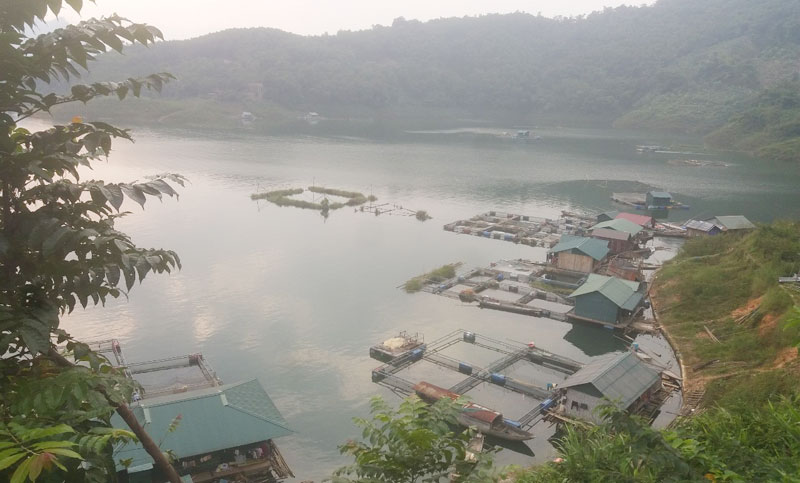
(HBO) - The construction of the Hoa Binh hydropower plant began in 1979. Hundreds of families surrounding the reservoir, including those of Thai Thinh commune, now Hoa Binh commune of the city of the same name, had to leave their residential land for the work.
More than 40 years later, with practical
support policies, lives of those residents went through various changes.
 Caged
fish farming and tourism development are among the orientations for economic
growth of villages around Hoa Binh reservoir in Hoa Binh city.
Caged
fish farming and tourism development are among the orientations for economic
growth of villages around Hoa Binh reservoir in Hoa Binh city.
To stabilise people’s lives, provincial People’s
Committee rolled out a number of support programmes and projects in the
locality. Over the recent past, the committee has approved a project linking the
production with consumption of caged farming fish on Hoa Binh reservoir.
Accordingly, firms will work with locals to
organise a production chain in tandem with consumption of fishery products under
VietGAP standards within three years. As many as 100 cages will be produced, which
is projected to raise over 518 tonnes of fish, raking in more than 20 billion
VND (865,000 USD).
Additionally, Party organisations and
authorities of Hoa Binh commune and Thai Binh ward viewed tourism around the
reservoir a strength in terms of economic development. In many villages,
households make use of natural landscapes comprising of forests, the reservoir
and cultural identity to develop community-based tourism.
Bich Tru village is home to 43 families with
stilt houses. Located on a favourable location with a view of the reservoir and
clean atmosphere, local families are working to turn their houses into an
attractive tourist destination.
As a result of the support policies, including
on-going road building projects, people’s lives witnessed various changes. Of
them, roads leading to Thau and Voi villages (Thai Binh ward) were opened to
traffic years ago, while that linking Bich Tru village with Vay Nua (Da Bac
district) is under construction and expected to complete soon, offering chances
to bolster trade, production, regional linkage and improve people’s lives./.
Nguyen Thi Nu, a resident of Thach Ly sub-area in Da Bac township of Da Bac district, has been popular in the area as a simple woman that is rich in compassion. For nearly 10 years, she has spread her kindness through many charity activities to ease difficulties for the needy.
Voluntary blood donation (HMTN) is a noble and humane gesture. 24 years ago, the Prime Minister issued Decision No. 43/2000/QD-TTg on mobilizing and encouraging Voluntary blood donation and designated April 7 every year as "All-People Voluntary blood donation Day”. This is an important milestone in the movement of voluntary blood donation, creating a strong change in the awareness and action at all levels of the government and people from all walks of life.
Yen Thuy is aiming to become a new-style rural district by 2025. To achieve this goal, the district has been mobilising the entire political system and local people to early fulfil required criteria.
From a normal bamboo tree, Nguyen Van Nam in Yen Tri commune, Yen Thuy district has transformed it into a "bamboo dragon". His works have been present in many countries.
On March 27th, the Public Security of Cao Phong District launched the model of clever mobilization "The Adopted Children of the Communal Police” advised and implemented by the Police of the communes and the town in coordination with the Youth Communist Union and the Women’s Union of the District Police.
According to the People's Committee of Tan Lac district, Hoa Binh province, by the end of 2023, Tan Lac district has 10/15 communes that meet new rural standards, with an average of 16 criteria per commune. The entire district has 14 OCOP products, including 13 3-star OCOP products and 1 4-star OCOP product; 18 model residential areas and 57 model gardens were recognized.



 Caged
fish farming and tourism development are among the orientations for economic
growth of villages around Hoa Binh reservoir in Hoa Binh city.
Caged
fish farming and tourism development are among the orientations for economic
growth of villages around Hoa Binh reservoir in Hoa Binh city.